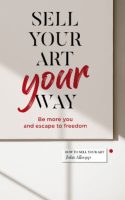Video 1: delivering value
Get steady art sales using search marketing
I’m John Allsopp, I’m an artist marketer, I talk to a lot of artists. Many are selling occasionally but not often enough.
I think I know why.
In that position, you’ll often have to be careful about money. Your projects might sometimes have to go on hold while you wait for the next chunk of money so you can buy art supplies. It’s fairly dispiriting and that can feed on itself and affect your art practice, but I don’t think that’s at the core of it.
It’s much more than that. They say that the opposite of war isn’t peace, it’s creativity. It turns out that whole suffering artist thing was, frankly, a lie to keep us down. We are most creative when we are free. Imagine how different it would feel if you were confident that all your costs were comfortably covered by art sales.
Imagine what you would do on the first day you woke up and saw that your future was safe and you could do art all day if you wanted.
What would it feel like to have an easy marketing process that was powerful and felt right to you.
By the way, I’m not touting one process. I’m saying there’s a place you can reach where this is true for you, but everyone has to push through to their own answer. I am saying I’m here to help you do that.
I work for myself, we are very much alike. Many of your battles are my battles too. But I have 40 years of marketing experience and skills and I do think there’s something fundamental that most artists miss.
It’s easy to see why. In practising your art, it may be necessary for an artist like you to dig deep inside yourself. To challenge yourself. To build on your skills. To wrestle with issues and ideas and turn them into art.
And then you meet a potential buyer and they go “what’s this all about then?” and you go “I’ve been wrestling with ideas” and they shrug and wander off to the coffee shop.
The biggest idea, in all that I teach, is that although the art is about you, the marketing is about them.
And where you are practised and skilled at looking inwards, perhaps you are a bit rusty at looking outwards.
So let’s try something.
What values do you live for?
What do I mean by values? Here are some:
- Uniqueness
- Affection
- Grace
- Congruency
- Skillfulness
- Exhilaration
Choose the one that’s most important to you, above all the others. (You can do more of this exercise over at johnallsopp.com .)
See, if you stand for skillfulness, you’ll be into jazz not punk rock and maybe your art will be hyper-realistic. If you stand for grace you might be into fashion or ballet and perhaps you’ll paint portraits. If you stand for exhilaration you’ll be into Formula 1 and do drip painting.
Us humans, we connect on values. If I’m into meditation and you are an adrenaline junkie, we are not going to find much in common. Even worse, we don’t even want the same sort of world. We’re not fellow travellers.
Worse still, meditators really just want a peaceful world, and the adrenalin junkies keep turning up with jet-skis. Frankly, meditators are against adrenalin junkies.
So if you stand for meditative peace and it’s clear that you do from looking at your art, what you want is for people who also stand for meditative peace to discover you, to turn up to your events, and to support you, perhaps by buying your paintings, by sharing, commenting, whatever. And you don’t want any adrenaline junkies turning up to nitpick.
More than that.
If you have set up your life as an artist to pursue meditative peace, you may be a long way further forward than the person who lives for that value but has kids at school and a job to go to. From their point of view, you’re leading the way. You’re a leader. You’re ahead of them on the journey.
You’re their focus. They are watching what you do. You have a follower who admires you, who may buy one of your paintings to represent what they want and keep them focused.
The group of people you now belong to, the meditative peace clan, will comprise people with many skills. You may find a musician who wants the same world. My favourite, an aromatherapist. You live for the same values, but have pursued different paths.
By the way, this highlights another brilliant thing about values based marketing. You are not contained. You can do oil paintings one week, sculpture the next, and write songs the week after but your values will be consistent, and so your followers will follow you wherever you go.
Back to the musician and the aromatherapist. Since you share a common dream, you are fellow travellers, it builds your status if, when you exhibit, the aromatherapist has mixed you a scent and your musician friend’s music is playing in the background. And at their gigs, and in their practice, your art is around.
If you have a thousand people on your mailing list and so do they, and those people are all also meditative peace people, you can cross market.
And if you share your connections and build out this value-driven environment, for the person wandering in and discovering your art, the music, the scent, it’s a persuasive world where they feel like they’ve ‘arrived’. It’s home.
Values are at the core of it all, for me, but you can also share common ground if you paint Massey Ferguson tractors or portraits of Frank Zappa or .. squirrels or whatever.
So the core, fundamental exercise is to think about what you stand for, and who are your people. I’ve never felt more at one with a group than when I (and the other participants) collected our photographs from the Baltic after Spencer Tunick’s event there, and people talked in the coffee shop about their experience. Spencer Tunick is a photographer who gets a crowd of people naked for a photograph. Those were my people. People who were willing to be vulnerable for art.
So .. after this go and do the exercise at johnallsopp.com .. it takes a bit of effort, be warned, you need a bit of time and maybe a wine or a coffee.
And take a while to think through what you stand for and what that means in terms of your audience, where they are, what are they like, and what do they want from you.
Everyone has many vectors. They are here and they want to be there. They have toothache and they want a dental appointment. They are bored at work and they want to leave. They are hungry for pizza. They need a laugh with close friends.
What can you give them that’s of value to them, to help them move from where they are to where they want to be?
I sometimes get the response: “I’m a pure artist, I don’t want to think about what will sell”.
I think that’s closed thinking.
Firstly, if you work out this fundamental stuff, you’ll love marketing (or at least hate it less) because you’ll find a way to further your art by marketing it in a way that’s congruent, and the income that results will help to support you and make you feel right in what you are doing. The creative challenge is to find a way to market yourself and enjoy it, because it comes from the same values as your art practice, and through that you’ll gain confidence and strength in your work by enjoying the support and the connection to others.
Secondly, if you are producing pure art without any feeling for whether it will sell, that’s still a service to the world. You are boldly exploring, pushing boundaries, breaking through. There are people who need to know what you are doing. People who need to be inspired by you.
And finally, why are you doing what you do? There’s a possibility that you are diving in to art as personal salvation. It’s your way of coping with .. it could be all sorts of things, trauma, PTSD, health issues whatever, or it could just be your way of feeling good, no more than that. So .. hang on. You’ve discovered something. It’s like you’re a scientist who’s discovered a treatment. But you’re not going to tell anyone? Others who are wrestling with these issues need you.
We have a responsibility to make our mark.
We stand on others shoulders, and now it’s our turn.
Am I being cynical?
Do I not have something to sell at some point.
I do have something to sell, but I’m not forcing your hand. I want to share some of the core concepts so you can get a sense of what my course is like and what it would be like for you, to go through the transformation.
I want you to think about a better future for yourself.
And if you really have no money, you can literally take what I’ve just taught you for free and it’ll make a difference, and when I open up my course again in a year’s time, maybe then you’ll be ready.
Anyway, this is my thing. When I went to university the first time wayy back in 1980, it was to study Computer Science. I wasn’t happy, and I kept finding myself in the arts library. I’ve only recently realised that that was where this mixing of art and digital tech started for me.
And the biggest wow moment from my time in Leeds was reading about the moment when you sit down at the computer terminal and you are faced with a new document, a blank screen, and through coding, through software, you can create anything you like. That got me.
So this idea of switching the focus away from you the artist and towards your buyer, and aligning your art as something of value that can help them get where they are going, that’s really the biggest lesson I’ve got to give. And I just gave you it for free.
However, that’s not all. You could do all this core work, but it will all be for naught if no-one sees it.
I have another video coming up and I’ll talk about how to get traffic to your website. So keep an eye out, and an ear to the ground. And your nose in the air. I think I just reinvented Twister .. and I’ll look forward to helping you with traffic generation in the next video.
Got questions or something to say? Drop me a comment or email me at john@johnallsopp.co.uk
Take care. Sell art.
J

